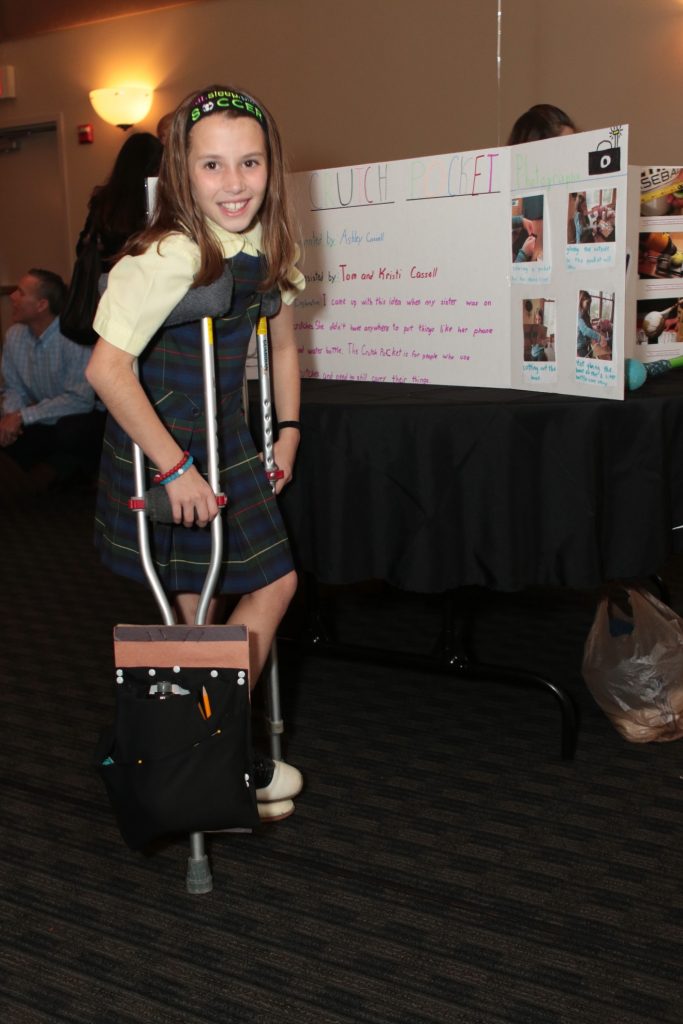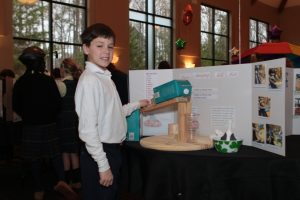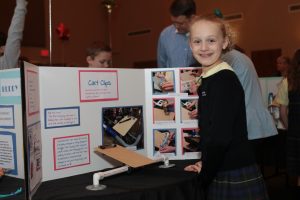The following article was contributed by Elizabeth Bierly, M.Ed., 4th Grade teacher at St. Jude the Apostle Catholic School.
St. Jude the Apostle Catholic School in Atlanta, Georgia held their 8th Annual Invention Convention this year. This project was introduced to St. Jude by a current teacher who had prior experience with it at another school. The purpose of Invention Convention is to combine 4th grade science and language arts standards while also strengthening skills in art and public speaking.
 Invention Convention is a two month project asking students to solve a problem with a creative solution. The problem can be something they, or something someone they know, are experiencing. While this project is done at home, the students have a series of deadlines to meet along the way. Once they get their idea (problem) approved by the teacher, they begin their first assignment which is to write how they think they will go about creating their invention (solution). The students have a week to describe the problem they are solving, what materials they think they will use, and what they hope the outcome will be. The two weeks following, they will draw and label a blueprint of what they think their invention will look like. Students will need two hand drawn copies; one to turn in and one to put on their display board. The students have the option of drawing a side view, top view, etc., in addition to, the required front view. At the same time, they will start building their invention with assistance from family members and write the steps of how they went about building it, using time order words. About halfway through the project, students sign a form indicating if their invention is complete and works or if they need more time perfecting it. Their last assignment, which they have two weeks to complete, is to create a display board exhibiting their invention name, who assisted them, the problem they were solving, the materials they used, their hand drawn blueprint, and four to six photographs with captions sequencing the steps of their creation. This display board is special ordered so it is small enough for the convention, as opposed to, the display boards found in stores. For the last assignment, the students each take a turn presenting their inventions to the class and demonstrating how their invention works. Following student presentations, we host our Invention Convention. The room is set up with round tables with 4 students at each table. Parents and grandparents are invited to this open house style event. They are given a pamphlet indicating which student is at which table along with their invention name. After the parents leave, they have a short snack break before 3rd grade comes to visit. The third graders get to have a peak of what to expect for next year and start thinking of ideas. The experienced 5th graders get to see what else has been invented. Although some inventions are repeated, most of them are completely original and pertain to an actual problem the student is having at that moment in their life.
Invention Convention is a two month project asking students to solve a problem with a creative solution. The problem can be something they, or something someone they know, are experiencing. While this project is done at home, the students have a series of deadlines to meet along the way. Once they get their idea (problem) approved by the teacher, they begin their first assignment which is to write how they think they will go about creating their invention (solution). The students have a week to describe the problem they are solving, what materials they think they will use, and what they hope the outcome will be. The two weeks following, they will draw and label a blueprint of what they think their invention will look like. Students will need two hand drawn copies; one to turn in and one to put on their display board. The students have the option of drawing a side view, top view, etc., in addition to, the required front view. At the same time, they will start building their invention with assistance from family members and write the steps of how they went about building it, using time order words. About halfway through the project, students sign a form indicating if their invention is complete and works or if they need more time perfecting it. Their last assignment, which they have two weeks to complete, is to create a display board exhibiting their invention name, who assisted them, the problem they were solving, the materials they used, their hand drawn blueprint, and four to six photographs with captions sequencing the steps of their creation. This display board is special ordered so it is small enough for the convention, as opposed to, the display boards found in stores. For the last assignment, the students each take a turn presenting their inventions to the class and demonstrating how their invention works. Following student presentations, we host our Invention Convention. The room is set up with round tables with 4 students at each table. Parents and grandparents are invited to this open house style event. They are given a pamphlet indicating which student is at which table along with their invention name. After the parents leave, they have a short snack break before 3rd grade comes to visit. The third graders get to have a peak of what to expect for next year and start thinking of ideas. The experienced 5th graders get to see what else has been invented. Although some inventions are repeated, most of them are completely original and pertain to an actual problem the student is having at that moment in their life.
Some of the inventions that were presented this year were “Mason’s Amazing Milk Mate”. The problem was that the student always spilled the milk when pouring a glass from a brand new container. This creation provided a spill-free solution for not only him, but for toddlers or senior citizens. Another invention was the “Crutch Pocket”. When this student’s sister was on crutches, she realized how hard it was for her to carry supplies to each class, so she came up with a pocket that sits at the lower end of the crutch to carry all of her essentials. The “Cart Clip” was another creative solution to a problem this student’s mother had while grocery shopping. There was no flat surface to use for her grocery list, so she solved this problem by attaching a small clipboard to a clip that fastened firmly to the handle of a grocery cart each time they went grocery shopping.
This project is a challenging, yet valuable experience for the students. They brainstorm, use trial and error, draw, write, and use their creativity to solve a real world problem.


